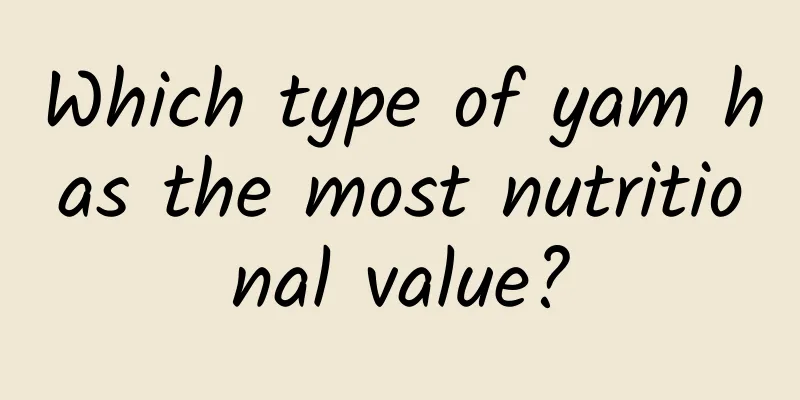The efficacy and function of white soil yam

|
The environment is now seriously deteriorating and various diseases are emerging one after another. In order to prevent the occurrence of various diseases and ensure good health, many people choose to enhance their immunity through diet. As a food ingredient that can fundamentally regulate various functions of the body, Chinese medicinal materials have received widespread attention. Today I will introduce to you the medicinal herb white soil Poria cocos. [Other names] Baidixie, Bai Tuling, Tu Fuling, Tiejiazi Tu Fuling, Jiuniu Li, Qianjin Li, Tudixie [Source] Medicinal material source: The tuber of Smilax china, a plant of the Liliaceae family. [Original form] Smilax glabra is a climbing shrub. Glabrous, branchlets with obtuse edges. Leaves are alternate; petiole 1-3cm long, with tendrils and narrow sheaths in the lower 1/3-1/4; leaves are papery, ovate-acuminate or cordate, 6-20cm long, 2.5-12cm wide, acuminate or short acuminate at the apex, with a mucronate, and more or less cordate at the base; there are 5-7 main veins, and the veinlets are reticulate. Umbels grow in leaf axils or in brown bracts; inflorescences are flat, 1-3 cm long; inflorescences are spherical; pedicels are slender, 2-7 mm long; male perianth tube is oblong or obovate, 3.5-4.5 mm long, with 3 blunt teeth at the top, 3 stamens, about 2/3 of the perianth length, anthers are more than 1/2 of the filament length; female perianth is simply ovate, 2.5-3 mm long, with 3 reduced stamens, ovate ovary, and 3-lobed stigma. The berries are oval. [Habitat distribution] Ecological environment: Growing in dense forests on hillsides at an altitude of 500-1800m or under mixed woods on the roadside. [Properties] 1. Identification of properties: The rhizome is irregular in shape, 10-30cm long, 5-8cm in diameter, yellowish-brown and rough on the surface, with hard fibrous root residues, white around the cross section, yellow in the center, and the powdery slices are 1-3cm thick; the cut surface is slightly rough, with small bright spots, soft in texture, and light in taste. [Chemical composition] Contains β-sitosterol (β-sitosterolI), palmitic acid (palmaiticacid) and stearic acid (stearic acid) etc. 【Nature and flavor】 sweet; bland; neutral 【Functions and indications】 Clears away heat and dampness; detoxifies and reduces swelling. It is used for urinary incontinence, leukorrhea, leucorrhea, carbuncle, swelling and sore. [Usage and Dosage] For oral use: decoction, 15-30g. 【Excerpt】 Chinese Materia Medica White Poria cocos is often used in the treatment of some diseases. It can be made into a compound prescription or used alone as needed. However, White Poria cocos should not be consumed blindly to avoid adverse effects on the body. |
<<: The efficacy and function of paparazzi flower
>>: The efficacy and function of the stems and leaves of Pulsatilla
Recommend
La Niña may reappear. Will floods in my country increase in summer?
(Photo courtesy of TUCHONG Creative) The El Niño ...
"The Hunchback of Notre Dame", a tragedy caused by square dancing?
Hunzhi helps you read the famous book "Hamle...
Sea salt, iodized salt, low sodium salt... How to choose between different types of salt? Many people eat the wrong salt
In the past two days, "buying salt" and...
How come the swing keeps swinging higher and higher with no one pushing or pulling it?
Audit expert: Luo Huiqian Associate Researcher, I...
The efficacy and function of crucian carp bones
Crucian carp bones have a long history, and until...
As a close relative of bears, why don’t giant pandas hibernate?
Key Points ★ Giant pandas are able to lower their...
Side Effects of Rhodiola Rosea
The side effects of Rhodiola rosea include gastro...
The efficacy and role of insect relatives
Speaking of Jia (Chongqi), we are all familiar wi...
The efficacy, function and consumption method of cinnamon twig
Diseases need good treatment methods, and the mos...
Being kissed repeatedly, the fever reached nearly 40℃! Don't do these things!
Recently, the topic #Baby was kissed by relatives...
If I had to choose only one between a cat (dog) and a boyfriend, I would choose...
In recent years, I have been surprised to find th...
How to distinguish between raw and processed Polygonum multiflorum
Everyone knows that Polygonum multiflorum is a me...
[Grain Policy of a Great Country] The seafood freedom of this generation of young people depends on the "smart factory" in the sea
The Central Government's No. 1 Document for 2...
The efficacy and function of yellow clematis
Most Chinese medicinal materials have good effect...
What is the difference between ginseng and codonopsis?
Ginseng and Codonopsis are both common Chinese me...









